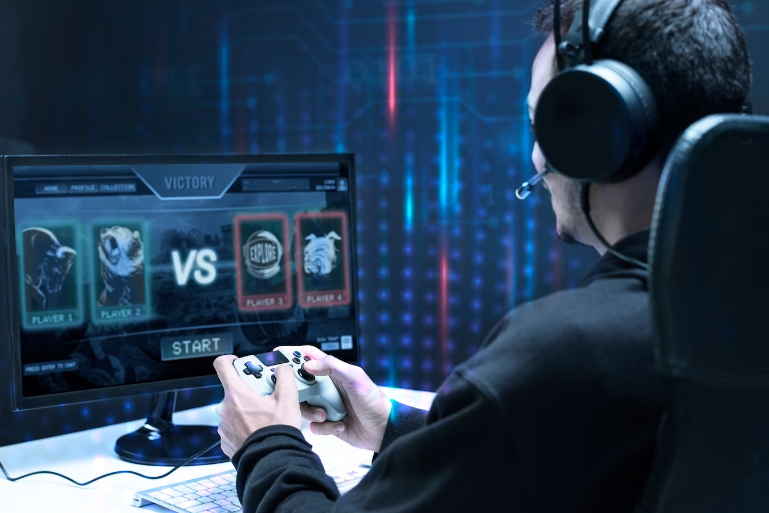Esports, short for electronic sports, has rapidly evolved from a niche hobby into a global phenomenon. Competitive gaming has taken the world by storm, with millions of fans tuning in to watch professional players compete in popular titles like League of Legends, Counter-Strike: Global Offensive, and Fortnite. Behind the scenes of this gaming revolution lies a complex ecosystem of technology, both hardware and software, that plays a pivotal role in shaping the competitive landscape.
In this blog, we’ll dive into the fascinating world of esports technology, exploring gaming peripherals, streaming setups, and the profound impact of high-performance hardware on gameplay.
The Evolution of Esports Technology
To truly appreciate the significance of technology in esports, it’s essential to understand its evolution. In the early days of competitive slot gaming, players relied on standard hardware and software, often with limited customization options. However, as the esports industry grew, so did the demand for specialized equipment that could enhance player performance and provide a more immersive viewing experience for spectators.
Gaming Peripherals: Precision at Your Fingertips
When it comes to competitive gaming, having the right peripherals can make all the difference. Professional gamers invest in high-quality keyboards, mice, and headsets to gain a competitive edge. These peripherals are often designed with specific features tailored to gaming, such as faster response times, customizable key bindings, and ergonomic designs.
- Keyboards: Esports keyboards are known for their lightning-fast response times, often utilizing mechanical switches. These switches provide tactile feedback, allowing players to register key presses with exceptional precision. Customizable RGB lighting and macro keys are also common features, enabling players to fine-tune their setups to match their preferences.
- Mice: Gaming mice are engineered for precision and speed. They often come with adjustable DPI (dots per inch) settings, allowing players to control the sensitivity of their cursor or crosshair. Additionally, many gaming mice feature customizable weight systems, enabling players to find the perfect balance for their aiming style.
- Headsets: Clear communication and immersive audio are crucial in team-based esports. High-quality gaming headsets offer noise-canceling microphones and surround sound technology, ensuring that players can hear every footstep and callout.
Streaming Setups: Turning Gamers into Celebrities
Streaming has become an integral part of the esports ecosystem. Popular platforms like Twitch and YouTube Gaming have turned professional slot gacor gamers into celebrities with massive followings. However, building a successful streaming setup is no small feat.
- Capture Cards: Capture cards are essential for streaming gameplay from consoles and high-end PCs. These devices capture video and audio signals from the gaming system and transmit them to the streaming software. They are crucial for maintaining high-quality streams with minimal lag.
- Webcams: Facecam feeds provide a personal touch to streams, allowing viewers to see the reactions and expressions of their favorite players. High-resolution webcams and green screens for background removal are common in professional setups.
- Microphones: Audio quality is equally important in streaming. Professional-grade microphones with noise cancellation and studio-quality sound can elevate a streamer’s presence and make their commentary more engaging.
The Impact of High-Performance Hardware
Esports isn’t just about flashy peripherals and streaming setups; the hardware powering the gaming experience itself plays a pivotal role in competitive success.
- Graphics Processing Units (GPUs): High-end GPUs are a cornerstone of esports performance. They ensure that players can run games at maximum settings, achieving high frame rates for smoother gameplay and reducing input lag.
- Central Processing Units (CPUs): Powerful CPUs are essential for multitasking during gameplay and streaming. They handle tasks like encoding video, running background applications, and maintaining a stable frame rate.
- Monitors: Esports professionals demand high-refresh-rate monitors with low response times. These monitors reduce motion blur and input lag, providing a competitive advantage by allowing players to react faster to in-game events.
- Peripherals: As mentioned earlier, specialized gaming peripherals are a must for competitive players. A fraction of a second can make the difference between victory and defeat, and high-performance hardware ensures that every input is registered accurately and swiftly.
The Future of Esports Technology
Esports technology is a constantly evolving field, with innovations occurring at a rapid pace. Here are some exciting developments on the horizon:
- Virtual Reality (VR) and Augmented Reality (AR): VR and AR technologies have the potential to revolutionize esports by providing more immersive experiences for players and viewers alike. Imagine watching a League of Legends match from within the game world or experiencing a CS:GO match as if you were on the battlefield.
- 5G Connectivity: Faster and more stable internet connections will reduce latency, making online competitions even more competitive. Players will experience less lag, ensuring that their skill and reaction time are the primary determinants of success.
- Artificial Intelligence (AI): AI-driven analytics tools can help players and teams analyze their performance in greater detail, offering insights on everything from strategy to individual player performance.
Conclusion
Esports technology has come a long way from its humble beginnings. Today, it’s a thriving industry with cutting-edge hardware and software solutions that drive both player performance and viewer engagement. As the esports scene continues to grow, we can expect even more exciting advancements in technology, making competitive gaming an even more thrilling and immersive experience for all involved. Whether you’re a professional player, an aspiring streamer, or a dedicated fan, the role of technology in esports is one that will continue to shape the future of gaming. So, gear up, level up, and get ready to embrace the exciting world of esports technology!




Leave a Comment